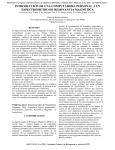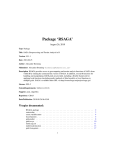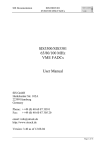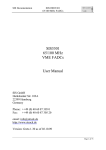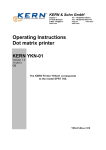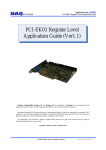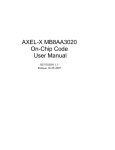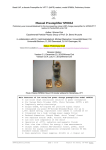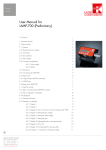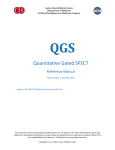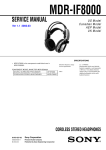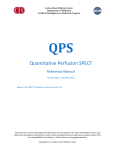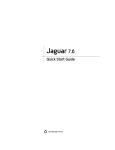Download AVM16 Manual V2.0 - W-IE-NE
Transcript
W-Ie–Ne-R AVM16 / AVX16 16 channel ADC, 160 MHz with features extraction User’s Manual V2.0 W-IE-NE-R Plein & Baus GmbH Board Rev. 1.3, Firmware Rev. 2.1, November 11, 2011 1 www.wiener-d.com General Remarks The only purpose of this manual is a description of the product. It must not be interpreted as a declaration of conformity for this product including the product and software. W-Ie-Ne-R revises this product and manual without notice. Differences between the description in manual and the product are possible. W-Ie-Ne-R excludes completely any liability for loss of profits, loss of business, loss of use or data, interrupt of business, or for indirect, special incidental, or consequential damages of any kind, even if W-Ie-Ne-R has been advises of the possibility of such damages arising from any defect or error in this manual or product. Any use of the product which may influence health of human beings requires the express written permission of W-Ie-Ne-R. Products mentioned in this manual are mentioned for identification purposes only. Product names appearing in this manual may or may not be registered trademarks or copyrights of their respective companies. No part of this product, including the product and the software may be reproduced, transmitted, transcribed, stored in a retrieval system, or translated into any language in any form by any means without the express written permission of W-Ie-Ne-R. W-IE-NE-R Plein & Baus GmbH 2 www.wiener-d.com Table of contents: 1 GENERAL DESCRIPTION............................................................................................5 1.1 Overview...................................................................................................................................5 1.2 Functional description.............................................................................................................6 1.2.1 Block diagram.....................................................................................................................6 1.2.2 AVM16 / AVX16 Feature Extraction..................................................................................7 1.2.3 Pedestal and Noise Extraction.............................................................................................9 1.2.4 Trigger Feature Extraction..................................................................................................9 1.2.5 Internal Trigger...................................................................................................................9 1.2.6 External NIM and Software Trigger..................................................................................10 1.2.7 Window Control................................................................................................................10 1.2.8 Trigger and Clock Synchronization...................................................................................11 1.3 Technical Specification..........................................................................................................13 2 TECHNICAL DESCRIPTION.......................................................................................14 2.1 Frontpanel Layout and Connector Description...................................................................14 2.2 DIP Switch and Jumper Position..........................................................................................16 2.3 Analog Input...........................................................................................................................17 3 DESCRIPTION OF VME INTERFACE.........................................................................18 3.1 VME addressing.....................................................................................................................18 3.2 VME registers.........................................................................................................................19 3.3 Technical Description of VME Registers.............................................................................20 3.3.1 Virtex5 Control FPGA Registers.......................................................................................20 3.3.2 Spartan3 ADC FPGA Registers........................................................................................23 3.3.3 Spartan3 Individual Channel Registers.............................................................................26 3.3.4 Virtex5 Data FIFO Readout Register................................................................................26 4 DATA FORMAT........................................................................................................... 27 4.1 Event Data Frames.................................................................................................................27 4.2 Data Preamble........................................................................................................................27 4.3 Data Decoding........................................................................................................................27 4.3.1 Raw Data Decoding..........................................................................................................27 4.3.2 Pulse Integral Decoding....................................................................................................28 4.3.3 Verbose Feature Extraction Data Decoding......................................................................28 W-IE-NE-R Plein & Baus GmbH 3 www.wiener-d.com 4.4 Data Frames...........................................................................................................................29 4.4.1 Compressed Data Frame...................................................................................................29 4.4.2 Verbose Data Frame..........................................................................................................30 4.4.3 Raw Data Frame................................................................................................................31 4.5 Example of Data Readout......................................................................................................32 5 PROM FILE FORMATTING.........................................................................................33 W-IE-NE-R Plein & Baus GmbH 4 www.wiener-d.com 1 1.1 General Description Overview The AVM16/AVX16 is a 1-unit wide VME64x/VXS module which allows for compact readout of physics experiments with very high channel count (16 per unit) while reducing the amount of transferred data to be stored and interpreted to a minimum. Hence the AVM16/AVX16 series allows for much higher trigger rates than raw data sampling with traditional FADCs. This is made possible by extensive use of local data compression power for each channel onboard. The implemented FPGA algorithm called feature extraction is capable to analyze any unipolar shaped physical signal coming from a scintillating plastic, crystal, a gaseous or silicon detector with a minimum useful rise time of 20-25ns and fall times lower than 3µs. It extracts all times, amplitudes and integrals of physical interest for any CR-RC or Gaussian shaped pulses from a detector. The feature extraction even works up to a pile-up factor of two or more, which means even searches for the inter-pulse minimum and a following maximum are possible. Due to a complex on-board triggering architecture up to 16 modules can be synchronized within one VME crate via daisy chaining on the frontpanel bus on the crate level while other crates can be point to point connected via the P2 backplane connector to form trees of synchronized crates. 1 The synchronization between the modules is done via modern multipoint transceivers compliant to the TIA/EIA-899 M-LVDS standard 2 on the front or backplane buses with flat cables to be terminated on both sides (internal jumpers are foreseen for the frontpanel bus). Overall trigger synchronization is guaranteed by high resolution system timers and a wide timestamp register. An overall busy logic is working on single eventbase filling a multi-event buffer FIFO as long as one or more modules flag for an internal readout FIFO overflow. The finally achievable trigger rate depends strongly on the analyzed window size, the verbosity level of the transmitted data (raw, verbose, compressed) and the chosen VME transaction strategy. For laboratory purposes one AVM16/AVX16 can be simply used as "single master" (SM) with internal 160MHz clock and external NIM trigger. Additionally every activated channel can be installed as internal trigger source (or-ed, featured trigger). The current channel baseline and noise are frequently recalculated. They are only updated within the pulse free time periods. Extended data transfer cycles via VME allow for up to 64 bit block moves (MBLT). An additional hardware byte swapper can be activated to ease readout transfer for little endian machines (INTEL) while default is big endian (Freescale, Motorola). Further extensions like VME Renaissance (2eVME, 2eSST) are physically possible as well as the optional VXS readout. Both are physically connected for possible customized implementations in the future (further firmware upgrades possible). Further hardware extensions may not be ruled out and may be proven on valued costumer request. 1 In this way a readout system with 480 BGO channel and of two multi wire proportional chambers (MWPC) has been designed 2 As used within current backplane xTCA physics extensions W-IE-NE-R Plein & Baus GmbH 5 www.wiener-d.com 1.2 Functional description 1.2.1 Block diagram The AVM16/AVX16 modules contain four quad-channel ADC blocks, a VME/VXS control part and a clock and synchronization system, see figure 1. Figure 1: AVM16/AVX16 Block-Diagram Each of the ADC channel is equipped with a symmetrizing amplifier, anti-aliasing filter and an individual 12-bit Analog-to-Digital converter running at 160 MS/s. After conversion, the digital data is passed to 4 FPGA circuits providing buffers for data retention and a feature extraction logic. One Spartan-3 FPGA from Xilinx is used for a block of four channels keeping a history of 2048 samples for each channel in its internal registers. W-IE-NE-R Plein & Baus GmbH 6 www.wiener-d.com Feature extraction algorithms are used to calculate important parameters of the input pulses such as amplitude, time, integrals and many others which allows to minimize the readout data volume and thus increasing the readout speed. The user may still choose to read a full set of samples recorded in the buffer or to read only a subset of those samples within the specified time boundaries being in relation to the trigger. After an internal or external trigger request the stored and/or extracted data is passed to a control VIRTEX-5 FPGA chip via four local data buses and then transferred over a VME bus or a VXS backplane P2P connection fabric. In multichannel systems where a common time base is required global clock and synchronization signals are provided either via the front panel connector or via user defined pins on the VME P2 connector. The clocking and synchronization circuitry allows for choosing of the correct clock source especially for bigger data acquisition systems. 1.2.2 AVM16 / AVX16 Feature Extraction 12-BIT 12-BIT 12-BIT ADC 12-BIT ADC ADC ADC DPRAM DPRAM DPRAM DPRAM TRIGGER BUS M U X (VXS Version) M M M M U U U UX X XX WINDOW WINDOW WINDOW WINDOW CONTROL CONTROL CONTROL CONTROL WAVEFORM WAVEFORM WAVEFORM WAVEFORM FEATURE ANALYSIS ANALYSIS ANALYSIS EXTRACTION FIFO FIFO FIFO FIFO CONTROL LOCAL BUS INTERFACE TRIGGER TRIGGER TRIGGER TRIGGER FEATURE FEATURE FEATURE FEATURE EXTRACTION EXTRACTION EXTRACTION EXTRACTION LOCAL BUS (data+ trigger+ timing) PEDESTAL PEDESTAL PEDESTAL PEDESTAL EXTRACTION EXTRACTION EXTRACTION EXTRACTION NOISEPP PP NOISE NOISE PP NOISE PP Figure 2: Feature extraction FPGA The following description of the Feature Extraction applies to every channel in the same manner: When no trigger occurs while the AVM16/AVX16 is running the current baseline (pedestal) and the current peak to peak noise value is regularly recalculated and updated. These values can be read out any time via VME for longtime monitoring purposes. The further Waveform Feature Extraction then strongly relies on the freshest recalculated baseline value. 3 Data coming from ADC converters are continuously stored in ring buffers (dual-ported RAM) synchronous to the global clock keeping a record of the last 2048 samples. Only 1024 of these samples can be selected from the window control for output to the Spartan local interface FIFO. 3 If baseline upsets or trips from the detector side may occur from time to time these can be tackled safely by the VME readout software only in verbose mode. If they can be completely ruled out compressed mode can be selected for highest trigger rates W-IE-NE-R Plein & Baus GmbH 7 www.wiener-d.com Data from within the boundaries of the window control called search window are transferred to the extended Waveform Feature Extraction section or - if raw data is additionally requested - to the readout FIFO. The Waveform Feature Extraction continuously searches in this window for physical pulses (in a kind of pipeline algorithm). If found a detailed list of parameters is extracted. Figure 3 shows such a list in case of a pile-up event. Those extracted values are made completely available via VME in verbose readout mode or in raw mode for any selected channel. An important parameter for further calculations is the self-extrapolated pulse start time Pz (left dashed line). For a detailed generation see §1.2.8. Finally when input pulses are bigger than a preset size their pulse integrals (Pq) are calculated precisely during run-time. The integration can be installed in two ways: Within an individually fixed time window after Pz or in a window starting at Pz but with a floating end. In the latter case the integration stops whether the end of integral window is reached first or the pulse amplitude has fallen back to 1/32 of its maximum before. Only the pairs (Pz,Pq) are transmitted to the central FIFO in compressed readout mode.³ If pileup events occur the process repeats for every peak. Figure 3: Feature extraction parameters P0 – window beginning Pi – first value greater the channels individual integral threshold Pz – pulse start time calculated from slope crossing the pedestal value Pa – signal amplitude Pq – signal integral (charge) * j – Pileup Number (in case of j=1 the brackets were suppressed in figure 3) PPi(j) – minimum value before pileup PPz(j) – pileup pulse start time calculated from slope crossing the current pedestal value PPi(j) PPa(j) – pileup pulse amplitude Pe(j) – pileup integral, starting from PPi(j), relative to the (common) baseline * If pileup occurs, the integral Pq is only calculated until PPi(j) time, else when 1/32 of Pa is reached, else when the integer window end comes before W-IE-NE-R Plein & Baus GmbH 8 www.wiener-d.com 1.2.3 Pedestal and Noise Extraction In periods free of trigger and pulses the AVM16/AVX16 Pedestal Extraction Feature steadily calculates the mean of 32 consecutive samples for every channel. Eight such mean values are stored in a pipeline register. Only if all of these values are within ±1 this common value becomes the new current pedestal or baseline value. In periods free of trigger and pulses the AVM16/AVX16 Noise Extraction Feature maximum peak to peak delta values are stored in individual noise registers. The maximum noise value is currently limited to a value of 31. It is reset to zero by its VME noise register read. 1.2.4 Trigger Feature Extraction For every activated4 channel the AVM16/AVX16 Trigger Feature Extraction steadily integrates four consecutive samples and stores the results in a pipeline. As soon as the value rises above a certain value5 (Pi) a pulse tagging mechanism takes place: For samples with distances of one, two or four samples the delta values will be calculated. Normally when a pulse peaks the pulse drops again. For a certain time 6 after the tagged maximum Pa only those delta values between ¼ and ¾ of Pa will be used for linear extrapolation of the different pulse start times to the current baseline. From all of these times the earliest becomes the pulse start or arrival time Pz with an internal resolution of ¼ clock period (1.5625 ns) and tagged by the ∆-method which has won, see figure 4. Figure 4: Graphical representation of the generation of the pulse start time Pz by the AVM16/AVX16 Trigger Feature Extraction 1.2.5 Internal Trigger Independently of the Trigger Feature Extraction for every channel an internal leading edge discriminator (sampling) is implemented for fast trigger decision on a one board level (Single or Local Master, see §1.2.8). The common threshold is programmable via VME trigger level register. Only the first Spartan3 FPGA trigger from all activated channels 4 becomes the event trigger referenced to from the local Virtex5 FPGA. If several trigger appear at the same time the trigger channel with the smallest channel number is chosen. The event trigger location can be readout via the VME state register. The event trigger is broadcast back to all 16 window controls, see §1.2.7. Additionally the event timestamp is broadcast in bigger system with more than one card or crate, see §1.2.8, but only one card in the system is installable with this featured internal trigger (LM) in the current hardware and firmware version. 4 non-inhibited, controlled via the VME cha_inh register 5 controlled via the channel selective VME q_threshold register 6 controlled via the VME anal_ctrl register W-IE-NE-R Plein & Baus GmbH 9 www.wiener-d.com 1.2.6 External NIM and Software Trigger External NIM trigger from the terminated frontpanel TRG LEMO connector can be accepted for fast trigger timestamp generation on base of the internal 640MHz clock reference. The timestamp has a resolution of 1,5625ns and is broadcast throughout the system in the same way as described for the Internal Trigger in §1.2.5. External NIM source is only selectable for mastered boards. The same rules are valid for the Software-Trigger, generated in-situ to the generated software call, and can be used for diagnostic purposes (software baseline and noise monitoring). With any accepted trigger the event number is increased by one, resettable via VME. 1.2.7 Window Control Either installed and non-inhibited trigger is distributed to all channels of an AVM16/AVX16 module. The trigger time is then used by the channels Window Control to set the time boundaries for Feature Extraction, means scanning/transmission of the dual-ported RAMs. Those boundaries are under full user control by four VME registers, see figure 5: • SW_START: Search Window Start. Also known as trigger latency, when positive means presamples, when negative refers to a postsample start, range (±6.4µs) • SW_LENGTH: Search Window Length. Transmitted size if raw data output is chosen (max. 1kS, 6.4µs) • IW_Start: Integral Window Start. For exclusion of early integration much before trigger • IW_Length: Integral Window Length. To additionally reduce maximum integration length Figure 5: Data window for feature extraction The Integral Window is only a sub-part of the Search Window. Additionally the SW_INTLENGTH variable limits the maximum width for the pulse integral extraction after Pz (PPz(j) in case of a pile-up event). It can be used with big success for nearly Gaussian shaped pulses, where tailored integral measurements cause no additional failures. W-IE-NE-R Plein & Baus GmbH 10 www.wiener-d.com 1.2.8 Trigger and Clock Synchronization Making extensive use of the frontpanel and backpanel synchronization connectors of the AVM16/AVX16 eases dramatically the final installation of a multi-module or multi-crate setup. The following figure 6 shows then how the trigger scheme follows a simple top-down structure: Figure 6: Trigger and Synchronization Scheme for bigger experiments To simplify the routing of the different possible clock and trigger sources in such a common synchronization scheme with flat cables the following nomenclature was introduced to help how to preset the modules VME mode registers: SM Single Master. Standalone module triggered by software, external NIM or internal Frontpanel Connector (FC) synchronization bus passive (high impedance) LM Local Master. Like SM. Driving FC synchronization bus LM_GW Local Master Gateway. Like LM, but additionally Driving VME-P2 Back Panel (BP) synchronization bus (used for inter crate synchronization) RM Remote Master. Synchronized via BP from a Gate Way (GW) module, Driving the local crates FC synchronization bus SLV Slave. Synchronization done by LM or RM, FC synchronization bus passive (high impedance) SLV_GW Slave Gateway. Synchronization done by LM, Driving BP synchronization bus Table 1: AVM16/AVX16 Module Mode Nomenclature W-IE-NE-R Plein & Baus GmbH 11 www.wiener-d.com The flat cables transfer differential M-LVDS signals. They have to be terminated on both ends by jumpers situated at the frontpanel and at the backpanel piggy connectors. The synchronization takes place automatically after power-up or a system reset SRST: Within some milliseconds the mastered synchronizing FPGA controllers (LM, RM) perform a full check of the functionality of the adapted flat cables, e.g. listening to correct transfer of the clock and trigger signals and re-initialize the system timers and timestamp registers. 7 The implemented Trigger and Clock Synchronization shall guarantee for full clock and event number synchronization and for broadcast delivery of the correct event timestamps during a completely asynchronous VME readout. The current states of the synchronization are to be monitored via the error flags retrievable within the AVM16/AVX16 masters VME mode registers. As long they are o.k. no sync. failure occurred. The implemented trigger scheme reduces tremendously the amount of external synchronization logic required for readout of the AVM16/AVX16 with no extra cost for the user. 7 The small trigger delays between modules of a crate and modules between crates are not recovered by the local or remote masters within the current firmware version W-IE-NE-R Plein & Baus GmbH 12 www.wiener-d.com 1.3 Technical Specification Bus standard VME64/VXS No. of channels 16 (LEMO connectors) Sampling speed 160 MHz Resolution 12 bit Input voltage range +/- 1.0 V Input offset DAC individual amplitude offsets (12 bit) Full bandwidth 141MHz Anti-aliasing filter user defined Default input coupling AC:* 280 kHz .. user defined, 50Ω terminated *customizations possible (DC, Gain) Noise 0.8 LSB (RMS) Buffer length 2048 samples (12.8 us), selectable 1024 max. Clock - Internal clock 160 MHz - External front panel connector M-LVDS/LVPECL - User defined VME P2 pins Trigger options - External NIM standard (LEMO connector) - Internal trigger (sampled leading edge) - Software trigger Feature extraction - Amplitude - Time of arrival - Charge integrals - Pile-up count of two or more Readout mode - Compressed (only charge and time for the main pulse) - Verbosity (full set of extracted parameters) - Raw (all samples plus full set of extracted parameters) Integration time window - relative to trigger time or to pulse arrival time - integral threshold individual for every channel - programmable relative pulse integral window System timer resolution - 1.5625 ns Self-Test Internal pulse generator with programmable amplitude Configuration - Remote via VME - Local via JTAG connector Base address A[31:16] selectable by 6-dip switch, from 0x0002 up to 0xC01E Addressing mode A32/D32, BLT, MBLT Power requirements VME-32 VME-64 W-IE-NE-R Plein & Baus GmbH +5V / 8A, +5V / 2.5A, +3.3V/5.5A 13 www.wiener-d.com 2 2.1 Technical Description Frontpanel Layout and Connector Description Figure 7: P2 VME Backplane Connector and pinout definition for M-LVDS bus Figure 8: The AVM-16 / AVX-16 Front Panel Layout W-IE-NE-R Plein & Baus GmbH Table 2: Flat Cable Connector pinout definition for M-LVDS bus 14 www.wiener-d.com 2.2 DIP Switch and Jumper Position Figure 9 shows the user key locations for jumpers and connectors Figure 9: The AVM-16 / AVX-16 Printed circuit board W-IE-NE-R Plein & Baus GmbH 15 www.wiener-d.com 2.3 Analog Input The default input AC filter provides an effective cut-off for background low frequency noise and mains pick-up. It is optimized for use in a typical QDC readout chain generating negatively shaped unipolar pulses of 2 volts dynamics. 12bit DACs allow to shift the baselines individually into the upper region to use the full dynamical range (12 bit). The symmetrizing amplifier provides a differential input for the 12 bit ADC reducing PCB noise pickup. The anti-aliasing filter allows for precise input bandwidth control. An on-board pulse generator provides a fast test pulse of programmable size to all channels for diagnostic purposes. Figure 10: Input symmetrizing amplifier and anti-aliasing filter (R5, R7, C2). Resistors values, the location of the test pulse and the values and locations of capacitors may depend on AVM16 version or be customized. Customization by manufacturer: Dynamic range of the inputs and the bandwidth of the anti-aliasing filters as well as DC coupling 8 can be easily adapted on customer request. Due to the unipolar input circuitry positive pulses can be sampled only with halve of range and resolution (11 bit). In this case the overall sampling polarity for positive feature extraction analysis can be switched via the VME control register. 8 The 0603 SMD 50Ω input termination is capable to sustain only a maximum power of 63mW and 50V peak voltage W-IE-NE-R Plein & Baus GmbH 16 www.wiener-d.com 3 3.1 Description of VME Interface VME addressing AVM16/AVX16 reacts to read and write accesses with following Address Modifiers (AM): >0F A32 supervisory block transfer (BLT) >0B A32 non privileged block transfer (BLT) >0D A32 supervisory data access >09 A32 non privileged data access >0C A32 supervisory 64-bit block transfer (MBLT) >08 A32 non privileged 64-bit block transfer (MBLT) Table 3: AVM16/AVX16 Address Modifiers The base address is set by means of a 6 fold DIP Switch SW1 according to following table: SW1 Bit Base Address 6 31 0x80000000 5 30 0x40000000 4 20 0x00100000 3 19 0x00080000 2 18 0x00040000 1 17 0x00020000 Table 4: Base Address Settings A switch in the „on“ position means that the corresponding address bit should be 0 (negative logic). The base address is divided in two parts. The gross range is set with SW1(6:5) and can be 0x0000000, 0x40000000, 0x80000000 or 0xC0000000. The fine range is set with SW(4:1) and can be from 0x000000 to 0x1E0000 with 0x20000 steps. The real base address is the sum of the two ranges. For example if only the switch 1 is set to “off” the selected address range will be 0x00020000 to 0x0003FFFC. The entire address range of the card is 0x20000, or 128kB. Of these ranges, the first kB (0x000 to 0x7FC) is determined for module registers and the rest (0x800 to 0x1FFFC) is determined for the block data transferred from the FIFO. This means with any addressed read from this range the data will be removed from the top of the data FIFO and transferred to the VME backplane. A re-read of the last FIFO word or FIFO block is not possible. BLT/MBLT can be done either with or without auto-address increment with blocks from 1-256 without a release of the data bus by the master. W-IE-NE-R Plein & Baus GmbH 17 www.wiener-d.com 3.2 VME registers Offset Name Write Read 0x000 ident Version 0x004 serial serial number, 32 Bit 0x008 com_ids communication identifier 0x00C mod_type Module Type Module Type and State 0x010 state Status Register 0x014 dlength Data length for block transfer as Byte 0x018 reserved 0x01C tp_dac Level of test pulse (DAC) 0x020 offset_dac[4] baseline offset for all ADC inputs 0x030 jtag_csr JTAG Control JTAG Status 0x034 jtag_data JTAG Runtest JTAG Data reserved 0x100 0x104 cr act Control/Mode Register action like Master Reset 0x108 cha_inh disable single channels, 16 Bit 0x10C cha_raw set channel to raw mode, 16 Bit 0x110 trg_level local trigger level, 12 Bit 0x114 anal_ctrl signal analysing control 0x118 iw_start start of integral window, 10 Bit 0x11C iw_length length of integral window, 10 Bit 0x120 sw_start start of pulse search window, 10 Bit signed 0x124 sw_length length of search window, 9 Bit 0x128 sw_intlength 0x12C 0x1300x13C aclk_shift lb_test[4] length of integral of the signal analysing step phase shift factor status r/w test register for the local bus (to 4 SPARTAN) reserved 0x2000x23C base_line[16] auto base line 12 bit 0x2400x27C noise_level[16] peak to peak noise level, 5 Bit 0x2800x2BC q_threshold[16] q-threshold for trigger decision in the integral window & data block gen. reserved 0x0800- data_range 0x1FFFC W-IE-NE-R Plein & Baus GmbH data, single or block transfer 18 www.wiener-d.com 3.3 Technical Description of VME Registers 3.3.1 Virtex5 Control FPGA Registers ident 0x000 - Board Id. Contains firmware version number. Bit Value Meaning 7:0 0x70 0x71 0x72 Module Id V1.1, common baseline, no NIM Trigger Module Id V1.2, wrong baseline, byte swap Module Id V1.3, actual Design 15:8 0x21 Firmware Version 31:16 0 Reserved (here 2.1), new Sync. System Serial 0x004 - User serial number. This number can be programmed by the user and is saved in the FPGA PROM. Read and write access possible. com_ids 0x008 - In this register there are three identifiers for communication. Bit Meaning 2:0 Interrupt Request Level (1 to 6) an interrupt is issued if data are available. A 0 disables the interrupt 3 Null 4 Byte Swap. 1 = Little endian, 0 = Big endian (default) 7:5 Null 15:8 Interrupt Vector, it is transmitted on Acknowledge in order to identify the interrupt Interrupt 19:16 Data recognition. These 4 bits are written in bit 31:28 of data, so that it is possible to map data to a specific module (see data format) 31:20 Null mod_type 0x00C - Module Type and Module Status Bit 2:0 Name typeid Meaning 0:SM Single Master. Independent module 1:LM Local Master. Trigger & controls frontpanel bus 2:LM_GW Gateway Master. Links to Remote Master via P2 3:RM Remote Master. Linked to a *_GW module via P2 4:SLV Slave. Synchronized via frontpanel bus by LM/RM 5:SLV_GW Gateway Slave. SLV links to RM via P2 3 SRSD Flag: Synchronization reset done 4 FCKF Flag: Frontpanel clock failure (applies not to SM) 5 RCKF Flag: Remote clock failure on VME P2 W-IE-NE-R Plein & Baus GmbH 19 www.wiener-d.com 6 FCKR Flag: Frontpanel clock ready (applies not to SM) 7 RCKR Flag: Remote clock ready 8 LMSB Flag: LM Setup Busy, wait until SLV are sync. 9 GCKF Flag: General Clock Failure (bit4 OR bit5) 10 LTSE Flag: LM Timeout during sync. setup 11 LTRM Flag: LM Timeout caused by RM 12 TTPF Flag: Trigger Time Parity Failure during broadcast 31:13 state Null 0x010 - General Status Register Bit Name Meaning 0 DVAL Data valid. Data are ready in readout FIFO. If this bit is set an interrupt is triggered in case the programmed interrupt level is not zero. The number of bytes in dlength register shall be read out. DVAL will be reset (and another interrupt will be generated) asynchronously, as soon as a new event is transferred to the readout FIFO 1 Null (lost meaning Firmware Version 2.1) 2 LBUSY Local Busy. This bit is set shortly when a trigger is accepted blocking further trigger until all the data is transferred internally to the readout FIFO. It is set also when no data can be transferred from the Spartan FIFO 3 BUSY System Busy. Sum of LBUSY of the whole system 7:4 LTSRC Level Trigger Source. Indicates which ADC channel fired the last level trigger. 8 FFULL FIFO Full. Flags overflow of the 128k readout FIFO 9 FERROR FIFO Error. If event size too big and FIFO stucks. This may be generally ruled out by design 31:10 dlength Null 0x014 - This register indicates how many bytes of data are ready for VME readout (e.g. BLT/MBLT) in the FIFO (128kB + reserve in total). The dlength count includes only complete event frames. Hence read out is fully asynchronous from data transfer as long as no FIFO overflow occurs. Data is packed into a special event frame format as described for the data_range register W-IE-NE-R Plein & Baus GmbH 20 www.wiener-d.com jtag_csr 0x030 - JTAG control/status Register Bit Name Write Read 0 TDI Data Input to the first JTAG device 1 TMS Mode Select 2 TCK JTAG Clock, must be zero when AUTO_CLK is used 3 TDO Data Output of the last JTAG device 4 RTEST JTAG Runtest is running 7:5 8 ENABLE drives signal to the JTAG Connector, the connector must be free 9 AUTO_CLK one clock cycle is generated, rising and falling edge With bit 8 set TDI, TMS and TCK on JTAG connector are driven from FPGA. Otherwise these signals are high impedance, in order for an external programming tool to be able to connect. By means of this register it is possible to enable a program to gain full control over the JTAG chain. For programming of the firmware by experts or the manufacturer the JTAG configuration connector with little imprint of the pins has to be used, see figure 6. jtag_data 0x034 - This register has two functions: α) With the read function the user gets the shift register for TDO. In order not to have to read jtag_csr after each output, the TDO bit is moved to a write register with each cycle, so that the last 32 TDO bits (e. g. Device ID) can be read out in chain. TCK shift TDO 30 16 15 0 jtag_data 31 16 15 0 β) With the write function a number of TCK Clocks with TMS=0 is returned. The value is used in svf Files as "RUNTEST n TCK". In this way it is possible to insert pauses after commands. tp_dac 0x01C - With bit 3 in “act” register it is possible to generate a test pulse through a DAC. The height of the test pulse is set by means of this tp_dac register. Since the DAC has only 8 bits, only bits 11:4 are relevant. offset_dac[4] 0x020 - When no signal is connected, the ADC mean output value is about 0x800, i.e. a signal in one polarity can use only half of the measurement range. By means of an offset value for a DAC, it is possible to reduce this ADC mean value until zero. For this purpose there are 4 12-bit DACs with 4 channels respectively. The DAC (AD5324) has the following SPI register assignments: W-IE-NE-R Plein & Baus GmbH 21 www.wiener-d.com Bit Name DAC Function (WO) 11-0 DATA 12 bit offset, one unit corresponds to about one ADC unit, i.e. when the value here is increased by 0x100, the ADC mean value when no signal is present should decrease more or less by the same value. 12 nLDAC If this bit is 0, all 4 channels are updated. This bit is always set to 0 internally. 13 nPD "not power down", this bit is set internally to 1 15-14 A1/A0 DAC channel group number 0 to 3 for offset_dac[0], 4 to 7 for offset_dac[1] and so on... 3.3.2 Spartan3 ADC FPGA Registers The read back of these registers occurs from a shadow register in VIRTEX-5. cr 0x100 - Control/Mode Register Bit Name Function 0 ENA General enable. If this bit is not set, AVM16 is in its ground state. All data is deleted. 1 EXTRIG Enables the trigger input from the front connector (LVDS). The trigger time is determined in VIRTEX-5 and sent to all ADC FPGA, in order to start the analysis. The next trigger is then only possible when all data have been transmitted to VIRTEX-5. 2 LEVTRIG With this bit a trigger is fired when the value of an ADC input (that is not inhibited by cha_inh ) overcomes the value in trig_level register. The corresponding ADC FPGA sends the trigger time to VIRTEX-5 which forwards it to all ADC FPGA in order to start the read out. 3 VERBOSE If zero means full compression: Only pairs (Pz,Pq) If one means verbose mode: Additionally the pairs of values for minima and maxima are transmitted. Full data is output to channels of cha_raw register 4 ADCPOL The polarity of the ADC data can be changed here. By default ADC data are inverted to analyse negative pulses. When this bit is set ADC data are not inverted to analyse positive pulses. Also the RAW data are inverted. 5 SGRD Single Gradient. In the computation of the rise time only two points with ∆x=1 are considered. Normally ∆x can also be 2 or 4, if the corresponding y values lay between ¼ and ¾ of the maximal value. 6 TP_ON With this bit the test signal can be statically enabled. 7 PW_ON With this bit, the analogue ADC power supply can be statically enabled. Otherwise, it is only enabled when bit 0 (ENA) is set. W-IE-NE-R Plein & Baus GmbH 22 www.wiener-d.com act 0x104 - Action register Bit Name Write/single shot 0 MRST Master Reset 1 SRST Synchronous Reset for all timers, so that all FPGA have the same time reference. 2 TRIGGER Software Trigger 3 TPULSE Generates a fast test pulse on all 16 channels Bits 3:1 are only relevant for modules in Single Master (SM) or Local Master (LM) mode, see mod_type register. Those signals will be sent to all allocated Slave Modules in the synchronization scheme. A software triggered pulse is generated when bits 2 and 3 were synchronously set. cha_inh 0x108 - The corresponding channel to each bit (0 bis 15) which is set is inhibited, means removed from readout, trigger and feature extraction. cha_raw 0x10C - If the corresponding channel to each bit is set all ADC raw data samples that are within the search window are transmitted together with all available data from the feature extraction (including start, point value pairs, integrals). trig_level 0x110 - This value is the common trigger level when LEVTRIG in cr register is activated, relative to internally regularly updated baseline of every channel anal_ctrl 0x114 - Here it is possible to parametrize the pulse analysis: Bit Default Function 3:0 8 Integral based detection: this value times 4 indicates how high should the integral be in order for a pulse to be detected. In case of a pile up the integral is computed on the basis of the last minimum value. 7:4 11:8 Null 1 Distance from another maximum: number of clock units after the last maximum (start time point) from where a new pulse (even a pile up) can be detected. 31:12 Null The default values are restored by reset or by writing 0. A zero as parameter is not valid and will be ignored. W-IE-NE-R Plein & Baus GmbH 23 www.wiener-d.com iw_start 0x118 - Start of the supplementary integral window within the search window. The time unit is the ADC sample rate (6,25 ns). The value must be bigger or equal to 4, in order for the 4 values leading the window to be present for calculating the informational search window start pedestal. iw_length 0x11C - Length of the integral window in units of the ADC clock. The end of the integral window plus 4 should not overcome the end of the search window. The time unit is the ADC sample rate (6,25 ns). sw_start 0x120 - Start of the search window for the range of internal trigger time search. The range is -512 to 511 times 12,5 ns (±6,4 µs). Positive values mean halved number of presamples before trigger time and negative values mean halved number of postsamples after trigger time. sw_length 0x124 - Length of the search window. The time corresponds to the value plus 1 times 12,5 ns. The maximum value is 511, i.e. 6,4 µs. Summary of constraints to be respected: IW_START >= 4 IW_START + IW_LENGTH + 4 <= SW_LENGTH; sw_intlength 0x128 - Integral length of pulse integrals in ADC sample rate units (6,25 ns). After a reset the value is set to maximum (0x03FF) by default, see §1.2.7. aclk_shift 0x12C - The ADC clock must have a fixed phase to the FPGA clock, in order to correctly transmit ADC data. For test purposes it is possible to change the phase, e.g. in order to determine whether the default phase is set correctly. The default phase is 0. Bit 0 4 8 12 1 5 9 13 2 6 10 14 ADC 3..0 7..4 11..8 15..12 3..0 7..4 11..8 15..12 3..0 7..4 11..8 15..12 Write Read Execute a step Step executed 0 for positive step and 1 for negative step Upper or lower limit reached, overflow Reset number of steps to 0 0 160 steps in one or the other direction correspond to ±180°. lb_test[4] 0x130 to 0x13C - Every one of the 4 SPARTAN-3 FPGA has a data test register, for testing the local data bus. These registers should be writeable with any 16 bit value and it should be possible to read this value back. After a MRST values 0x1230 to 0x1233 are preset for the 4 FPGA W-IE-NE-R Plein & Baus GmbH 24 www.wiener-d.com 3.3.3 Spartan3 Individual Channel Registers base_line[16] 0x200 to 0x23C – Read Only. The ADC mean values for all channels are continuously updated and can be monitored by these addresses, see §1.2.3. noise_level[16] 0x240 to 0x27C – Read Only. The peak noise amplitude is computed for each channel individually by subtracting the minimum value from the maximum value outside of pulses since the last read, see §1.2.3. An individual read call resets the noise level for a new measurement. q_threshold[16] 0x280 to 0x2BC – Write Only. Individual threshold levels for pulse integral recognition within the Feature Extraction. If a value is zero the integral of the corresponding is something like the sum of all signals (also noise) over the integral window and hence is not of special interest. Instead a positive value with the meaning of a minimum detection energy makes sense. 3.3.4 Virtex5 Data FIFO Readout Register data_range 0x400 to 0x1FFFC – event data frames stored in the VIRTEX-5 FIFO can be read out through this address, independently from which address in this range is read, so that also an incremental block transfer is possible. Single transfers as well as block transfers BLT and MBLT are allowed. In MBLT a trailing empty word is filled up with a zero word. If the FIFO is empty >FFFFFFFF is output. A second read of data contents is not possible by FIFO definition. For the kind of data format see following chapter . W-IE-NE-R Plein & Baus GmbH 25 www.wiener-d.com 4 Data Format The AVM16/AVX16 data format is quite complex due to the high compression factor realized. The whole event data format is structured in 32 bit words of 4 Bytes where the 32 bits may be subdivided into a preamble part for localization on the most significant section of the word and a data part on the least significant section of the word, with size and units depending on a decoding part in between both sections. This is mixed up also with identification due to the output sequence. The endianness of the readout interface must be checked first before a correct decoding is possible (can be changed by bit 4 of com_ids register). 4.1 Event Data Frames Events are additionally kept in blocked event data frames with a frame header, see table 4. Word # Word Format 0 10…0 Description EVBLN[17:0] Length of event block EVBLN in bytes 12B .. ~17kB 1 TTSP[31:0] Trigger timestamp in units of 1,5625 ns (640MHz) 2 EVN[31:0] Event number, reset to zero by SRST EVBLN/4:3 Preamble Decoding Data Words (compressed, verbose, raw) Table 5: Event Data Frame structure with three word Frame Header 4.2 Data Preamble In general the data words preamble (or word header) is itself coded in the following way: Word [31:22] 31 30 29 28 27 26 25 24 23 22 Code U3 U2 U1 U0 0 0 C3 C2 C1 C0 Table 6: Data Preamble for localization of events 4.3 U[3:0] : Card address. To be programmed via register com_ids[19:16] C[3:0] : Channel address. Generated automatically Data Decoding 4.3.1 Raw Data Decoding Word[21:0] 21:12 11:0 Code 0 D[11:0] D[11:0]: ADC raw data, if 0xFFF means overflow, if 0x000 means underflow The Raw Data record repeats sw_length times until it stops with code ≠ 0 W-IE-NE-R Plein & Baus GmbH 26 www.wiener-d.com 4.3.2 Pulse Integral Decoding Word[21:0] 21 20 19:0 Code 1 0 Pq, Pe(j) Pulse Integral in ADC units. Negative values are only possible if q_threshold of the corresponding channel is zero, else it is always positive (see §3.3.3) and may overflow during baseline upsets or signal excitations (e.g. trips, see also OVF variable in §4.3.3). 4.3.3 Verbose Feature Extraction Data Decoding The following table 6 gives an overview over the coding structure of the Feature Extraction Data: Word[21:0] 21 20 19 18 17 16 15:0 Description Verbose Mode Entry Code Block 1 Code + 0x30 1 1 0 0 0 0 sw_start Search window start time 2 Code + 0x31 1 1 0 0 0 1 base_line Channel baseline Verbose Mode Single Pulse Code Block 1 Code + 0x32 1 1 0 0 1 0 t(Pi) 2 Code + 0x33 1 1 0 0 1 1 Pi 3 Code + 0x34 1 1 0 1 0 0 t(Pa) 4 Code + 0x35 1 1 OVF 1 0 1 Pa 5 Code + 0x36 1 1 1 0 0 1 q_threshold trigger time First value above q_threshold Pulse peaking time Pulse peak amplitude ∆X[1:0] Pz Pulse start time, ∆X method Verbose Mode Pileup Pulse Code Block 1 Code + 0x32 1 1 0 0 1 0 t(PPi(j)) 2 Code + 0x33 1 1 0 0 1 1 PPi(j) 3 Code + 0x34 1 1 0 1 0 0 t(PPa(j)) 4 Code + 0x35 1 1 OVF 1 0 1 PPa(j) 5 Code + 0x36 1 1 1 0 0 1 ∆X[1:0] Pileup pulse start time Pileup minimum Pileup pulse peaking time Pileup pulse peak amplitude PPz(j) Pileup pulse start time, ∆X m. Verbose Mode Pulse Integral Code Block 1 Code + 0x37 1 1 0 1 1 1 base_line 2 Code + 0x37 1 1 0 1 1 1 base_line_start 3 Code + 0x20 4 Code + 0x37 Channel baseline mean … at search window start Pulse Integral Decoding, see §4.3.2 1 1 0 1 1 1 base_line_end … at search window end Table 7: Addressed and sequenced decoding structure of Feature Extraction Data W-IE-NE-R Plein & Baus GmbH 27 www.wiener-d.com OVF: Overflow bit. To additionally flag for overflow and underflow events ∆X[1:0]: ΔX-bin decoding. Smallest Pz, PPz(j) was achieved with bin value 1, 2, 4 Units and types: All times are in units of the system timer, 1,5625 ns (640MHz). Respectively Pz with signed 14 bit all time types are of signed 16 bit. Negative values count times before the event trigger. All other value units are in ADC bits. Types are of signed 16 bit. The sign refers to the orientation over or under the current baseline. Code Sequence: The preferred sequence within the data blocks while output is as given in the order indicated by the counter number left of the bordered boxes. 4.4 Data Frames 4.4.1 Compressed Data Frame Compressed mode is the most sparse data mode and should only be used if the overall ground and channel baseline stability has been proven as well as rare electrical upsets (trips, discharges) can be ruled out or tackled by another external system. In this case the Compressed Data Frame has a simple (Pz,Pq) structure, starting with the lowest channel number containing data above threshold - maybe sparse of some channels - to the highest channel containing data above threshold: First Event Block Length First Trigger Timestamp First Event Number Preamble first channel beyond q_threshold + Pulse Start Time Decoding 0x36 Preamble first channel beyond q_threshold + Pulse Integral Decoding 0x20 • • • Preamble last channel beyond q_threshold + Pulse Start Time Decoding 0x36 Preamble last channel beyond q_threshold + Pulse Integral Decoding 0x20 Second Event Block Length Second Trigger Timestamp Second Event Number • • • In case of pile-up further (PPz(j),Pe(j),j=1...N) couples with same channel number directly follow. Finally the sum of all individual EVBLN shall agree with the d_length FIFO byte count read out. W-IE-NE-R Plein & Baus GmbH 28 www.wiener-d.com 4.4.2 Verbose Data Frame Verbose mode allows to tackle for electrical upsets during run-time. To do this the baseline mean values four samples before the integral window and four samples after the integral window are output quite early in the Verbose Data Frame by the Verbose Mode Pulse Integral Code Block: First Event Block Length First Trigger Timestamp First Event Number With Preamble of first channel beyond q_threshold Verbose Mode Pulse Integral Code Block Verbose Mode Entry Code Block Verbose Mode Single Pulse Code Block Pulse Integral Decoding 0x20 • • • With Preamble of last channel beyond q_threshold Verbose Mode Pulse Integral Code Block Verbose Mode Entry Code Block Verbose Mode Single Pulse Code Block Pulse Integral Decoding 0x20 Second Event Block Length Second Trigger Timestamp Second Event Number • • • In case of pile-up further code blocks and pulse integrals are transmitted (!): With Preamble of channel beyond q_threshold with Pileup Verbose Mode Pulse Integral Code Block Verbose Mode Entry Code Block Verbose Mode Single Pulse Code Block Pulse Integral Decoding 0x20 Verbose Mode Pileup Pulse Code Block Pulse Integral Decoding 0x20 of Pileup Pulse Finally the sum of all individual EVBLN shall agree with the d_length FIFO byte count read out. Rarely Pulse Integral Decoding can be transmitted before the Verbose Pulse Code Block is ready! W-IE-NE-R Plein & Baus GmbH 29 www.wiener-d.com 4.4.3 Raw Data Frame While the Verbose Data Frame is changing the data frame format globally as described in the last paragraph the Raw Data Frame can be masked out by the cha_raw register individually. Hence in principal all channels can be read out in raw data frame mode or only a subset of them. In this way a DAQ expert can switch on and off simply a channel of his/her choice for monitoring purposes during run-time. This eases control of bigger readout systems from time to time without halting it. This switching is possible within compressed or verbose running DAQ systems. If selected cha_raw register the whole raw data record expands in its decoding structure (§4.3.1) maybe localized directly after the last not selected channel block or either behind the data frame header. For example to check for the Feature Extraction working properly during run-time the full Verbose Data Frame is automatically added behind: • • With Preamble of a channel beyond q_threshold Raw Data Record Verbose Mode Pulse Integral Code Block Verbose Mode Entry Code Block Verbose Mode Single Pulse Code Block Pulse Integral Decoding 0x20 • • • And in case of a pileup event with pileup factor of two: • • With Preamble of a channel beyond q_threshold with Pileup Raw Data Record Verbose Mode Pulse Integral Code Block Verbose Mode Entry Code Block Verbose Mode Single Pulse Code Block Pulse Integral Decoding 0x20 Verbose Mode Pileup Pulse Code Block Pulse Integral Decoding 0x20 • • Finally the sum of all individual EVBLN shall agree with the d_length FIFO byte count read out. W-IE-NE-R Plein & Baus GmbH 30 www.wiener-d.com 4.5 Example of Data Readout To give a practical example for a typical AVM16/AVX16 data frame the location identifier is set to zero (com_ids[19:16] = zero) and only the first three channels were non-inhibited (cha_inh=0xFFF8) and set to raw mode (cha_raw=0x0007), at a trigger point, in which all three channels see a pileup event at the same time, see figure 11: Figure 11: Possible example of data output This is an older example, but shows that the nomenclature has changed a bit from the new manual version (V2.0) to help for a better understanding. A cross check is given by the following tabular: New Nomenclature Old Nomenclature baseline or baseline at start / end of integral window mean level / preceding / trailing q_threshold trigger time (in integral window) minimum time first value above q_threshold (in integral window) minimum level pulse peaking time maximum time pulse peak amplitude maximum level single pulse 1 / first pileup pulse 2 / second The variable declarations as given by figure 3 (Pz, Pi, Pa, PPz(j), PPi(j), Pq, Pe(j), etc.) are those since start of the AVM16/AVX16 project, even if ordinates and abscissas had been a bit mixed up. To disentangle this the times are called t(...) within the code data tables. The pileup count has changed form two max. to more than two with the newest firmware version/s. Everyone should feel free to use an own nomenclature in the DAQ software for data processing. W-IE-NE-R Plein & Baus GmbH 31 www.wiener-d.com 5 PROM File Formatting In the case a new firmware version exists distributed by W-IE-NE-R directly or is made remotely available via the W-IE-NE-R Download File Server the expert user may check first whether it fits to the corresponding board version and if a corresponding new manual version exists (if needed). Then the following instruction shows up how an hardware expert may reconfigure the board to the new firmware version with the new .mcs file downloaded, together with an existing XILINX JTAG download cable and the existing IMPACT boundary scan software. Else, generally, W-IE-NE-R updates the boards firmware on costumer request. Figure 12: The AVM-16 / AVX-16 FPGA in the JTAG Boundary Chain How to program the PROM: 1- Connect the "Plattform Cable USB" to the dedicated JTAG pins. 2- Execute the impact.exe (It can be done from run dialog box or ISE program) 3- In the iMPACT program, run the "Boundary Scan" and then "initialize chain" from toolbox. A chain with 6 devices has to be appeared (Figure 12) 4- Right click on the xcf32p for a) "Assign New Configuration File..." (e.g. AVM16_v_2_1.mcs) b) "Set Programming Properties..." The following property values must be checked: b1) Verify b2) Design-Specific Erase Before Programming b3) Load FPGA b4) During Configuration: PROM is Slave(clocked externally) c) "Program" After this the AVM16/AVX16 is ready for powering up in a W-IE-NE-R VME64/VXS Crate. W-IE-NE-R Plein & Baus GmbH 32 www.wiener-d.com
































